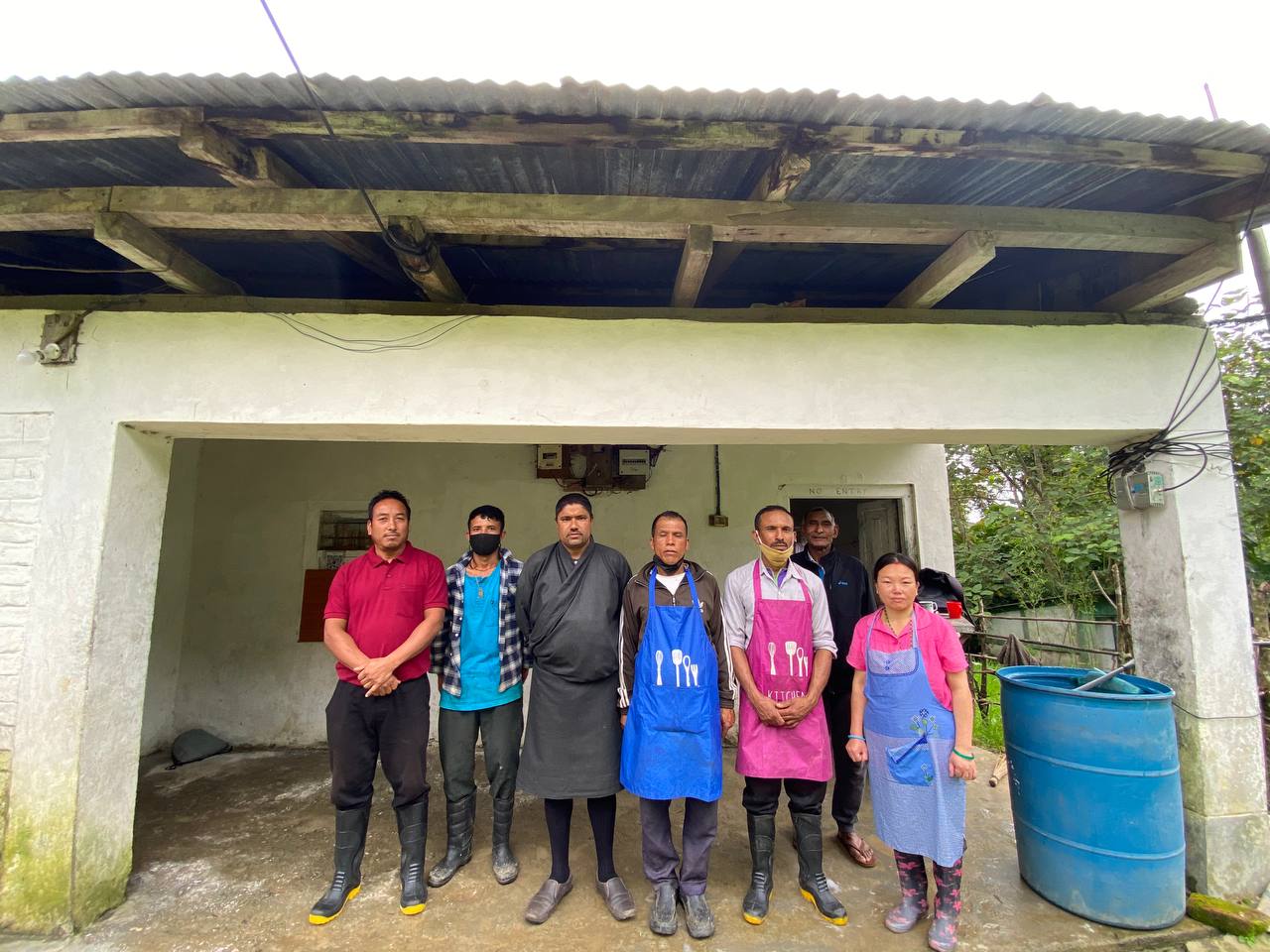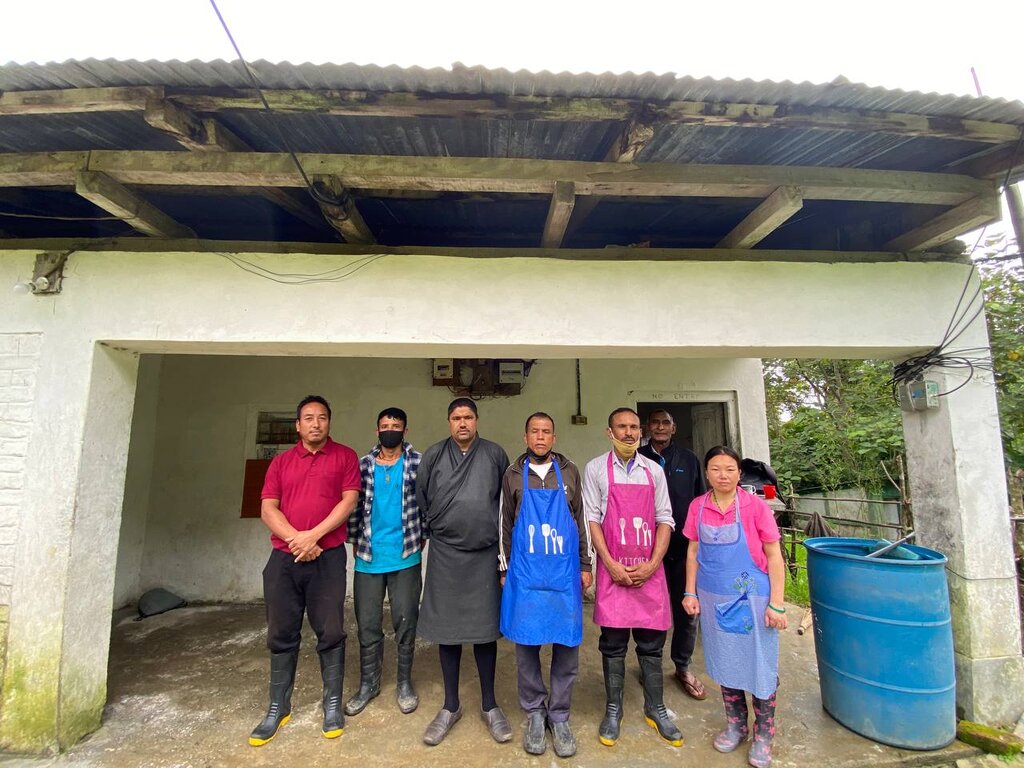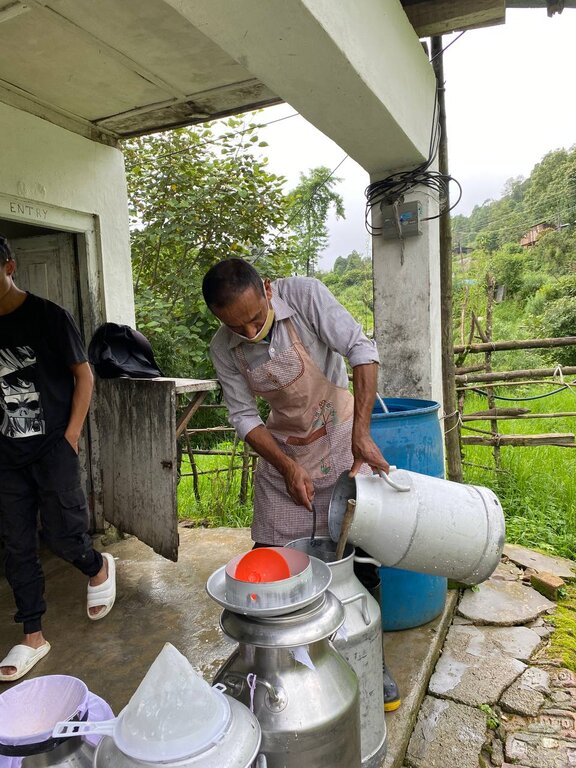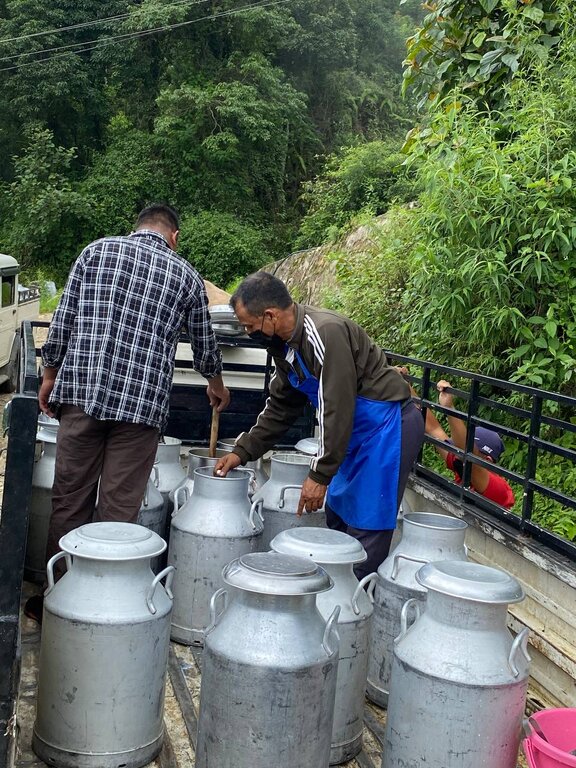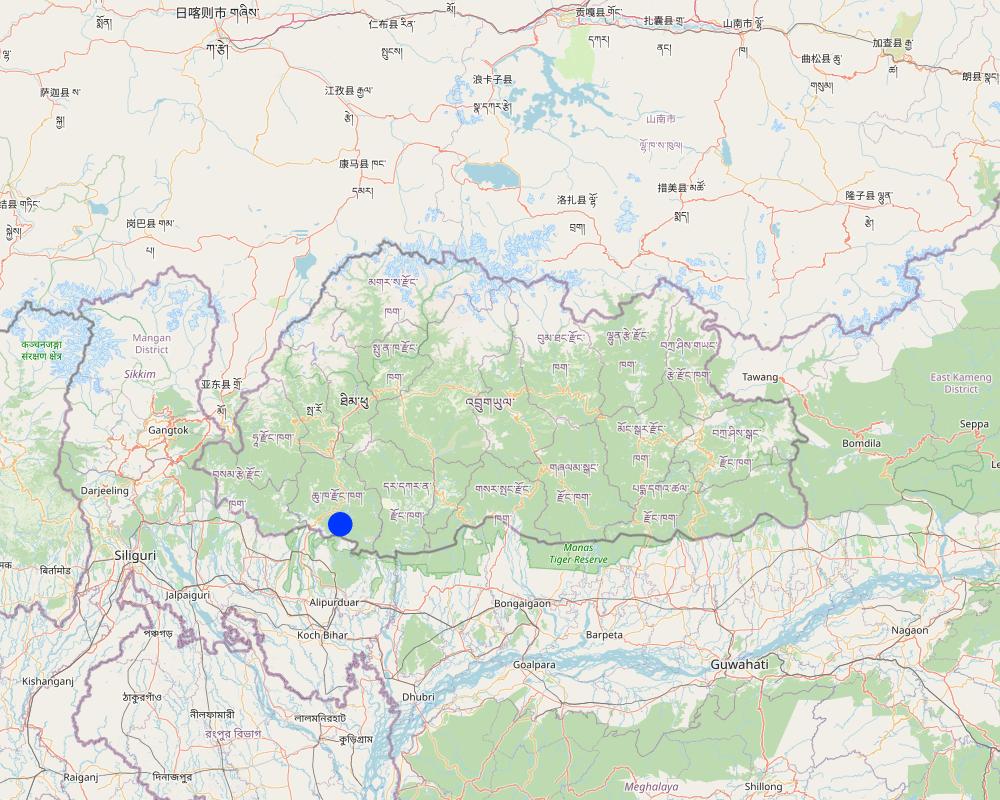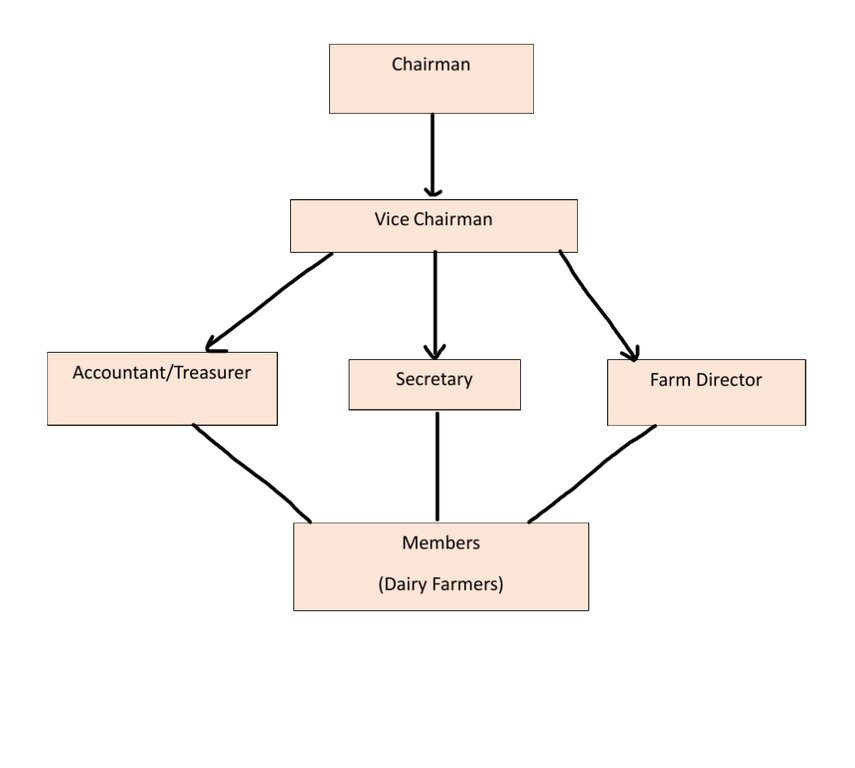Darla Dairy Cooperative [Bhoutan]
- Création :
- Mise à jour :
- Compilateur : Karma Wangdi
- Rédacteur : chenga Tshering
- Examinateurs : William Critchley, Rima Mekdaschi Studer
Gonor Nyamley Detshen (སྒོ་ནོར་མཉམ་ལས་སྡེ་ཚན།)
approaches_6868 - Bhoutan
Voir les sections
Développer tout Réduire tout1. Informations générales
1.2 Coordonnées des personnes-ressources et des institutions impliquées dans l'évaluation et la documentation de l'Approche
Personne(s) ressource(s) clé(s)
exploitant des terres:
Samal Bal Kumar
17720749
Darla, Chukha Dzongkhag (District)
Bhoutan
exploitant des terres:
Gurung Pancha Maya
16931238
Darla Dairy Cooperative
Darla, Chukha Dzongkhag (District)
Bhoutan
exploitant des terres:
Chettri Datta Singh
16911283
Darla Dairy Cooperative
Darla, Chukha Dzongkhag (District)
Bhoutan
exploitant des terres:
Basnet Chandra Kumar
17810553
Darla Dairy Cooperative
Darla, Chukha Dzongkhag (District)
Bhoutan
exploitant des terres:
Kharki Ram
17480128
Darla Dairy Cooperative
Darla, Chukha Dzongkhag (District)
Bhoutan
Nom du projet qui a facilité la documentation/ l'évaluation de l'Approche (si pertinent)
Strengthening national-level institutional and professional capacities of country Parties towards enhanced UNCCD monitoring and reporting – GEF 7 EA Umbrella II (GEF 7 UNCCD Enabling Activities_Umbrella II)Nom du ou des institutions qui ont facilité la documentation/ l'évaluation de l'Approche (si pertinent)
National Soil Services Centre, Department of Agriculture, Ministry of Agriculture & Livestock (NSSC) - Bhoutan1.3 Conditions relatives à l'utilisation par WOCAT des données documentées
Quand les données ont-elles été compilées (sur le terrain)?
17/07/2023
Le compilateur et la(les) personne(s) ressource(s) acceptent les conditions relatives à l'utilisation par WOCAT des données documentées:
Oui
2. Description de l'Approche de GDT
2.1 Courte description de l'Approche
The Darla dairy cooperative is an example of where farmers come together to form collective organizations for production, collection, transportation, processing, and marketing of milk and dairy products. These are business models operated as member-owned and member-controlled organizations.
2.2 Description détaillée de l'Approche
Description détaillée de l'Approche:
Livestock in Bhutan are reared for a multitude of purposes, encompassing the production of milk, food, and dung, as well as serving as a means of generating draught power, generating revenue, and accumulating assets. Dairy products, particularly butter and cheese, occupy significant significance within the Bhutanese nutritional framework and have emerged as a noteworthy economic resource for certain households in recent times. Knowing its importance many Bhutanese farmers are forming the cooperative groups. One thing that has been constantly growing over the years in Darla Gewog under Chhukha Dzongkhag is a Farmer’s Cooperative.
Darla dairy cooperatives are business owned and operated by dairy farmers, designed to collectively manage market milk and dairy products (Singh & Gupta, 2015). One of their main features is the collective ownership structure, where farmers become members and actively participate in decision-making processes. By pooling resources, dairy cooperatives enable farmers to access shared facilities, such as milk processing plants and storage, reducing individual cost and enhancing efficiency. Additionally, they offer fair and transparent pricing mechanisms, ensuring farmers receive a competitive price for their milk. Dairy cooperatives also provide valuable technical assistant, training, and access to markets, supporting farmer's growth and sustainability in the dairy industry (USDA, 2015).
The aims and objectives of dairy cooperatives revolve around empowering dairy farmers and promoting their collective welfare. One of the primary objectives is to facilitate shared ownership and democratic decision-making, allowing farmers to collectively manage their dairy operation. Another key aim is to ensure fair and equitable distribution of profits among members, promoting economic sustainability and social development within the dairy community. Dairy cooperatives also strive to provide access to modern technologies empowering farmers with the knowledge and skill needed for sustainable dairy farming practices (FAO, 2019).
The formation of a dairy cooperative typically involves several methods and steps to ensure successful establishment. Firstly, a core group of dairy farmers with common goals come together to initiate the cooperative. They conduct meetings, gauge interest, and identify potential members. Once the core group is established, they create formal bylaws that outline the cooperative's objectives, membership criteria, decision-making processes and profit-sharing mechanisms. To attract more members, awareness campaigns and informational sessions organized by gewog livestock extension agents showcase the benefits of joining the cooperatives. Financial planning and livestock management efforts are also undertaken to raise the necessary capital for initial investments, such as setting up milk processing facilities and infrastructures. There are 101 registered dairy farmers who contribute milk through the cooperative. The dairy cooperative is operated by 6 core members who manage the daily activities.
Dairy cooperatives play a crucial role in the dairy industry by bringing together various stakeholders and facilitating their collaboration. The primary stakeholders involved in dairy cooperative includes dairy farmers who are the core members and owner of the cooperative. They actively participate in decision-making and contribute their milk to the cooperative for processing and marketing. Additionally, consumers are significant stakeholders as they rely on dairy cooperatives to provide them with high quality milk and dairy product. Other stakeholders like the gewog livestock extension agent, the District livestock officer and other officials are involved in a meeting which is conducted twice a year. Marketing opportunities are the main driving forces for producers to produce more of any type of product. Identification of market opportunities and the development of proper marketing strategies for milk and milk products for selected groups of villages would be a useful approach to support dairy cooperatives.
2.3 Photos de l'approche
2.5 Pays/ région/ lieux où l'Approche a été appliquée
Pays:
Bhoutan
Région/ Etat/ Province:
Chukha
Autres spécifications du lieu :
Darla
Map
×2.6 Dates de début et de fin de l'Approche
Indiquez l'année de démarrage:
2014
Si l'année précise est inconnue, indiquez approximativement quand l'Approche a démarré:
il y a moins de 10 ans (récemment)
2.7 Type d'Approche
- initiative/ innovation récente locale
2.8 Principaux objectifs de l'Approche
The dairy cooperative aims to increase income through marketing of surplus milk, by engaging unemployed youths. Such intervention is expected to address problem srelated to rural urban migration.
2.9 Conditions favorisant ou entravant la mise en œuvre de la(des) Technologie(s) appliquée(s) sous l'Approche
disponibilité/ accès aux ressources et services financiers
- favorise
Priority support is given to the group and cooperatives in terms of investment and financial support by the government.
collaboration/ coordination des acteurs
- favorise
Dairy cooperative enables farmers' to access and shared facilities, by pooling resources
marchés (pour acheter les intrants, vendre les produits) et prix
- favorise
Increasing demand for milk and dairy products motivate farmers' to raise more dairy cattle and increase production
charge de travail, disponibilité de la main-d'œuvre
- favorise
Enabled sharing of workload equitabily
3. Participation et rôles des parties prenantes impliquées dans l'Approche
3.1 Parties prenantes impliquées dans l'Approche et rôles
- exploitants locaux des terres / communautés locales
Dairy farmers
Actively participate in decision-making and, produce and supply milk to the cooperative for processing and marketing as specified in the bylaw
- gouvernement local
Livestock Extension Agent
Provide technical supports (health, feed and fodder, breeding and management) and monitor the progress of cooperative
- gouvernement national (planificateurs, décideurs)
District Livestock Officer
Royal audit authority
Assist in prioritization of issues and planning
Mobilize human and financial resources
Monitor and ensure adequate financial supports
3.2 Participation des exploitants locaux des terres/ communautés locales aux différentes phases de l'Approche
| Participation des exploitants locaux des terres/ communautés locales | Spécifiez qui était impliqué et décrivez les activités | |
|---|---|---|
| initiation/ motivation | interactive | The core dairy farmers with guidance from the Gewog Livestock Extension Agent came up with ideas to establish a dairy cooperative/group. |
| planification | interactive | Core members along with intellectual people from the village assisted by gewog livestock extension agent planned and proposed. |
| mise en œuvre | interactive | Interested dairy farmers supported by the gewog livestock agent and dzongkhag implemented the activity following the workplan and bylaws agreed upon. |
| suivi/ évaluation | soutien extérieur | The activities of the dairy cooperatives are monitored periodically through field visit, monthly report, Bi-annual general assembly meeting and annual audit. |
3.3 Diagramme/ organigramme (si disponible)
Description:
Presented flow chart of Darla Dairy cooperatives with engagement of all the members
Auteur:
Terms of Reference of Darla Dairy Cooperatives
3.4 Prises de décision pour la sélection de la Technologie/ des Technologies
Indiquez qui a décidé de la sélection de la Technologie/ des Technologies à mettre en œuvre:
- les exploitants des terres seuls (auto-initiative)
Expliquez:
The idea was conceptualized by the core group members, and accordingly planned and dairy cooperative was established initially. The engagement of other stakeholders came after the establishment.
Spécifiez sur quelle base ont été prises les décisions:
- expériences et opinions personnelles (non documentées)
4. Soutien technique, renforcement des capacités et gestion des connaissances
4.1 Renforcement des capacités/ formation
Une formation a-t-elle été dispensée aux exploitants des terres/ autres parties prenantes?
Oui
Spécifiez qui a été formé:
- exploitants des terres
Formats de la formation:
- sur le tas
Thèmes abordés:
Group mobilization, bookkeeping , planning
Hygienic and clean milk production, collection, transportation, and processing.
Breeding and management (AI, Housing, feeding system)
Commentaires:
The specialized training was provided by subject matter specialist, and on basic topic by the respective Extension Agent
4.2 Service de conseils
Les exploitants des terres ont-ils accès à un service de conseils?
Oui
Spécifiez si le service de conseils est fourni:
- dans les champs des exploitants?
Décrivez/ commentez:
Officials from NCOA Yusipang monitored their work, and livestock officials organized awareness program on the management, care, prevention and control of common cattle diseases
4.3 Renforcement des institutions (développement organisationnel)
Des institutions ont elles été mises en place ou renforcées par le biais de l'Approche?
- oui, modérément
Spécifiez à quel(s) niveau(x), ces institutions ont été renforcées ou mises en place:
- local
Décrivez l'institution, ses rôles et responsabilités, ses membres, etc.
The number of dairy cooperative members have increased by 15 households.
Précisez le type de soutien:
- équipement
Donnez plus de détails:
All members of the cooperative were supplied with milk cans to collect, store and transport milk
4.4 Suivi et évaluation
Le suivi et l'évaluation font ils partie de l'Approche? :
Oui
Commentaires:
Physical on site monitoring and evaluating the quality, standard, cleanliness of the work and products
Si oui, ce document est-il destiné à être utilisé pour le suivi et l'évaluation?
Non
4.5 Recherche
La recherche a-t-elle fait partie intégrante de l’Approche?
Non
5. Financement et soutien matériel externe
5.1 Budget annuel de la composante GDT de l'Approche
Si le budget annuel précis n'est pas connu, indiquez une fourchette:
- 10 000-100 000
Commentez (par ex. principales sources de financement/ principaux bailleurs de fonds):
The approach was implemented with the seed money collected from the members.
5.2 Soutiens financiers/ matériels fournis aux exploitants des terres
Les exploitants des terres ont-ils reçu un soutien financier/ matériel pour la mise en œuvre de la Technologie/ des Technologies?
Oui
Si oui, spécifiez le(s) type(s) de soutien, les conditions et les fournisseurs:
They were provided with the milk processing equipment
5.3 Subventions pour des intrants spécifiques (incluant la main d'œuvre)
- intrants agricoles
| Spécifiez les intrants subventionnés | Dans quelle mesure | Spécifiez les subventions |
|---|---|---|
| Machines | entièrement financé | -Chunning machine -Office furnitures - cream separator -analyzer -yogurt incubator -deep freezer and fridge |
Commentaires:
The government fully funded construction of milk processing, and is being operated by the cooperative free of cost.
5.4 Crédits
Des crédits ont-ils été alloués à travers l'Approche pour les activités de GDT?
Non
5.5 Autres incitations ou instruments
D'autres incitations ou instruments ont-ils été utilisés pour promouvoir la mise en œuvre des Technologies de GDT?
Non
6. Analyses d'impact et conclusions
6.1 Impacts de l'Approche
Est-ce que l'Approche a autonomisé les exploitants locaux des terres, amélioré la participation des parties prenantes?
- Non
- Oui, un peu
- Oui, modérément
- Oui, beaucoup
They got more recognition and support
Est-ce que l'Approche a permis la prise de décisions fondées sur des données probantes?
- Non
- Oui, un peu
- Oui, modérément
- Oui, beaucoup
future plans are drawn based on the needs, issues and challages faced during the operation of dairy cooperative
Est-ce que l'Approche a construit/ renforcé les institutions, la collaboration entre parties prenantes?
- Non
- Oui, un peu
- Oui, modérément
- Oui, beaucoup
Physical and financial support received have enhanced, improved social cohesion
Est-ce que l'Approche a amélioré l'égalité entre hommes et femmes et autonomisé les femmes et les filles?
- Non
- Oui, un peu
- Oui, modérément
- Oui, beaucoup
Every men and women is given equal right.
Est-ce que l'Approche a conduit à améliorer la sécurité alimentaire et/ou la nutrition?
- Non
- Oui, un peu
- Oui, modérément
- Oui, beaucoup
Increased milk and dairy products and excess dairy products are processed and supplied to schools, hospitals and other markets.
Est-ce que l'Approche a amélioré l'accès aux marchés?
- Non
- Oui, un peu
- Oui, modérément
- Oui, beaucoup
Formalized group marketing, and the quality of milk products have improved
Est-ce que l'Approche a conduit à des emplois, des opportunités de revenus?
- Non
- Oui, un peu
- Oui, modérément
- Oui, beaucoup
Some school drop-outs and laid-off youths are employed in collecting and transportation of milk.
6.2 Principale motivation des exploitants des terres pour mettre en œuvre la GDT
- augmenter la rentabilité/ bénéfice, rapport coûts-bénéfices
Member earn an average gross monthly income between Nu. 30000-40000
- paiements/ subventions
Government provide subsidies (materials support) for the construction of improved dairy shed
- affiliation à un mouvement/ projet/ groupe/ réseaux
Their products are marketed within the gewog, and excess products are marketed to other districts
6.3 Durabilité des activités de l'Approche
Les exploitants des terres peuvent-ils poursuivre ce qui a été mis en œuvre par le biais de l'Approche (sans soutien extérieur)?
- oui
Si oui, décrivez de quelle manière:
The initial investment has been recovered, and current income meets the operation cost.
6.4 Points forts/ avantages de l'Approche
| Points forts/ avantages/ possibilités du point de vue de l'exploitant des terres |
|---|
| Source of cash income |
| Increased cooperation and network |
| improve household livelihood |
| Points forts/ avantages/ possibilités du point de vue du compilateur ou d'une autre personne ressource clé |
|---|
| Creates employment opportunities to the school drop-outs and rural youths |
| Contributes to food security and better nutrition |
6.5 Faiblesses/ inconvénients de l'Approche et moyens de les surmonter
| Faiblesses/ inconvénients/ risques du point de vue de l’exploitant des terres | Comment peuvent-ils être surmontés? |
|---|---|
| Scattered settlement and production | Increase the number of transportation vehicles, improve road connectivity |
| Short shelf life of milk | Try marketing in nearby places if possible, install cold chain facilities |
| Delay in payment | Create a terms of agreement with the retailers to ensure payment on time |
| Faiblesses/ inconvénients/ risques du point de vue du compilateur ou d'une autre personne ressource clé | Comment peuvent-ils être surmontés? |
|---|---|
| No proper market outlet for wholesale marketing | explore market outside gewog |
7. Références et liens
7.1 Méthodes/ sources d'information
- visites de terrain, enquêtes sur le terrain
5
- interviews/entretiens avec les exploitants des terres
5
7.3 Liens vers les informations pertinentes disponibles en ligne
Titre/ description:
Cooperatives in the Dairy Industry
URL:
https://www.google.com/url?sa=t&source=web&rct=j&opi=89978449&url=https://www.rd.usda.gov/files/cir1-16.pdf&ved=2ahUKEwi9z4b8-Z6AAxV7umMGHQsgBZUQFnoECBMQAQ&usg=AOvVaw0jmrAUETNEh8crEba04qjj
Titre/ description:
Dairy development through cooperative structure
URL:
https://www.fao.org/3/T3080T/t3080T0a.htm
Titre/ description:
Analysis of knowledge and adoption level of the dairy farmers regarding clean milk production (CMP) practices
URL:
https://www.indianjournals.com/ijor.aspx?target=ijor:jdfhs&volume=34&issue=3&article=002
Liens et modules
Développer tout Réduire toutLiens
Aucun lien
Modules
Aucun module trouvé


